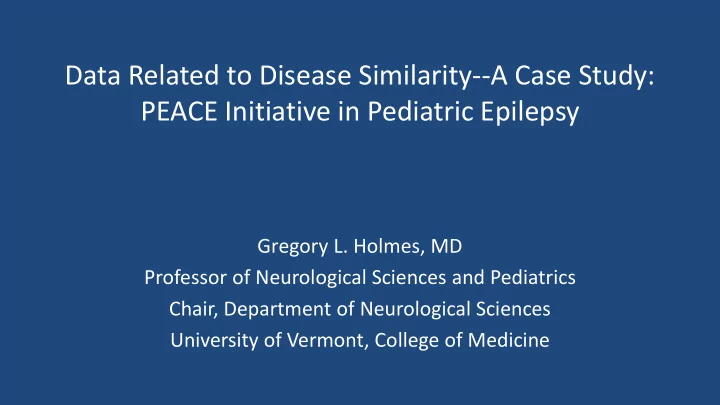

Data Related to Disease Similarity--A Case Study: PEACE Initiative in Pediatric Epilepsy Gregory L. Holmes, MD Professor of Neurological Sciences and Pediatrics Chair, Department of Neurological Sciences University of Vermont, College of Medicine
John M. “Jack” Pellock, M.D 12/25/1943 – 5/6/2016
PEDIATRIC EPILEPSY ACADEMIC CONSORTIUM FOR EXTRAPOLATION (PEACE) • In disease states affecting both adults and children, drugs are often approved for adult use before development in children is completed or even started. • Although antiepileptic drugs (AEDs) approved for use in adults can be prescribed off-label for children, this availability hampers pediatric drug development: – Raises parents’ concerns about enrolling children with refractory epilepsy in a trial of a marketed drug with placebo. – Creates an operational disincentive to undertake the challenges of conducting double-blind, randomized, controlled efficacy trials in children with seizures.
PEACE • In the absence of pediatric-specific labeling, prescribers lack critical information (e.g., dosing, tolerability/safety, age-specific monitoring) that can facilitate the appropriate and safe use of AEDs in this vulnerable population. • Expediting pediatric access to new AEDs is compelling since epilepsy is the most common serious neurological disorder in children. • Almost none of the AEDs approved for the management of focal (partial-onset) seizures included children <12 years of age in the initial clinical development program and were therefore marketed for use in older adolescents and adults.
PEACE • Since focal seizures occur in both children and adults, efficacy data from adults can be successfully extrapolated to children if there is scientific consensus that disease progression and response to intervention are similar in adults and children. • The focus of an argument for adult-to-pediatric efficacy data extrapolation in focal seizures is based on the similarity of seizure pathophysiology and the similarity of the clinical response to AEDs in terms of seizure control.
PREVALENCE OF GENERALIZED AND PARTIAL SEIZURES Pediatric Patients <15 Years Adults 35-64 Years Other Unknown/ Other partial multiple partial 7% Tonic-clonic 3% Unknown/ 6% Generalized Generalized seizures are more common in the first five years of life, 19% multiple tonic-clonic the incidence was similar for both between the ages of 6 and 24, 9% 27% and partial seizures were at least twice as common as generalized onset seizure in adults over 24 years. Absence . Complex 13% Myoclonic partial 2% 23% Other generalized Simple partial Myoclonic Complex 11% 13% Simple 7% partial partial 49% 11% Hauser, 1992
PEACE Rational • Because anti-epileptic drugs are not evaluated as disease- modifying drugs (i.e. not anti-epileptogenic) the focus of an argument for adult-to-pediatric efficacy data extrapolation is based on the similarity of seizure pathophysiology….. – Key factors in E/I balance as function of age – Network maturation – Neurophysiological maturation – Seizure and EEG semiology • and the similarity of the clinical response to AEDs in terms of seizure control.
Developmental Aspects of Receptor Development
GABA is Excitatory in the Neonatal Brain Cl - taken up by NKCC1 Overwhelms Cl - extrusion by KCC2 High intracellular [Cl - ] +ve Cl - equilibrium pot. GABA A activation results in Cl - efflux & depolarization Depolarization causes glutamate release, further excitation via GLU-R
Bumetanide Potentiates the Effect of Phenobarbital Bumetanide selectively inhibits NKCC1 Reduces intracellular [Cl - ] Reversal of Cl - equilibrium potential GABA A activation causes Cl - influx & hyperpolarization Hyperpolarization prevents excitation, glutamate release
Jensen and Silverstein, 2007
P11 P18
PCW 31 PCW 45 PCW 168
Theta Rhythm Rats: 4-12Hz Humans: 4-8Hz 1 second Sample press Match press Frequency (Hz) 4 8 12 4 8 12 0 1 2 3 4 5 -5 -4 -3 -2 -1 0 Time from press (sec) Theta power increases when a rat travels across the chamber Time-locked to lever pressing behavior (Sample & Match presses)
Single Unit Recording Method Buzsáki, Nature Neuroscience , 2004
Rate Coding
Beyond Rate Coding – Temporal Coding of AP’s by the Phase of Theta
Replay of Place Cells in Sleep O’Neill, Trends in Neurosciences, 2010 Matt Wilson Diekelmann and Born, Nature Neuroscience Reviews, 2010 modified from Ji and Wilson, Nature Neuroscience, 2007
Maturational Dynamics of Place Cells in Immature Rats Ontogeny of the place cell system in rats studied between P22 and P43, a time during which there was a rapid improvement in spatial behavior. Place cells with adult like firing fields were observed at the earliest ages, but were few in number. Firing rate and stability increased with age and the average spatial signal of all pyramidal cells improved.
4 yo Alpha Frequency 16 yo
4 yo 16 yo Kurth et al., 2013
Seizure Characteristics that Change with Age
EEG Parameters by Age Nordli et al., 2001
Efficacy Comparison of Differences in Median % Seizure Reduction Between the Baseline and Treatment Periods by Drug for Children and Adults Pellock et al, 2012
Placebo-subtracted median percent seizure reduction between baseline and treatment periods (ranging from 7.0% to 58.6% in adults and from 10.5% to 31.2% in children) was significant for 40/46 and 6/6 of the treatment groups studied. The >50% responder rate (ranging from 2.0% to 43.0% in adults and from (3.0% to 26.0% in children) was significant for 37/43 and 5/8 treatment groups. Pellock et al, 2012
Summary • Based on anatomical and physiological data, from a focal seizure standpoint, physiological function of the brain of a 4 year old is similar to that of an adolescent. • By age 4 years the EEG is quite similar to that of an adolescent and adult. • The clinical semiology and EEG features of focal seizures in a 4 year old does not differ substantially from adolescents and adults. • The response to AEDs in focal seizures do not differ in children older than 4 years of age than adults.
Recommend
More recommend